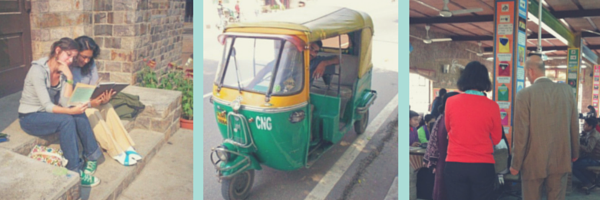Editor’s Note: This is Part II in a four part series highlighting public education challenges in New Delhi and how the U.S. charter model may be influencing education reform across the city. Part I is available here.
It’s been nearly 10 years since I lived as an international student in New Delhi, India. This January, I returned on business to learn more about “government partnership” schools—an exciting education reform initiative slowly taking shape in the city. This return—now as a professional in the education sector—was a powerful experience for me, both professionally and personally. Delhi felt at once familiar, but also more complex; these complexities seemed especially heightened given the high stakes of the education reform work we were now involved in.
My colleague William Haft and I spent a week touring nine elementary schools of various types—government, private, elite, and hybrid. In Part I of this series, William highlighted the persistent challenges struggling municipal or “muni” schools (government-run elementary that typically serve low-income and slum communities) face across Delhi, such as teacher absenteeism and flagging student engagement. When describing one of the schools we visited, he writes:
At one rural K-5 government school built for perhaps 200 students, there were six children present being supervised by a single teacher, who was not doing any teaching and whose indifference towards the children was unaffected by our presence.
As we walked through the muni schools, seeing these challenges take shape in real time, I was caught off guard by how familiar some of them felt. These were some of the same challenges I experienced inside of my college classrooms all those years ago.

Then and Now: Manager of Authorizer Development Erin Reddy as an international student in New Delhi, 2006; One of the many auto rickshaws that transport college students to class each morning in Delhi; Katha Lab School, a government partnership school the Authorizer Development team visited in January.
Monsoons, Monkeys, and Attendance
The summer of my junior year of college, I landed in New Delhi for the first time, excited and eager to begin my year as an international student at St. Stephen’s College. It was the middle of July, when the heat, violent rain, and humidity caused by the seasonal monsoons aggressively wraps around you like a heavy wool sweater. I have fond memories of climbing into the back of an auto rickshaw and puttering through the city to campus in the early morning fog, warm chai in my belly, passing troops of monkeys scouring the streets for food scraps.
St. Stephen’s is affiliated with Delhi University, the city’s public higher-education system, and is regarded as one of Delhi’s prestigious and exclusive learning institutions. Stephen’s typically receives thousands of applications each year for about 400 seats. The students come from some of the most elite and well-educated families in Delhi and across the country; however, per the Indian Constitution, the school also reserves seats for students from socially and educationally disadvantaged castes and tribes. Arguably, Stephen’s serves students from a broad economic spectrum.
Coming from a large public university on the east coast, the differences in my new learning environment were stark. In many ways, it was reminiscent of my uncompromising Catholic schooling: we sat at wooden desks on wooden chairs; sat before a singular chalkboard; wrote in notebooks—by hand—with a single professor discharging information at the front of the classroom. Student engagement in the classes I took involved “boomeranging” back the information the teacher had presented.
Even halfway around the world, I was eager to be a model student and took classes in topics I was interested in: Indian literature, history, and political science. Over the months, however, this eagerness withered and disappointment took root, namely because my professors did not consistently come to class; some would be absent for days. My own Indian classmates did not consistently come to class either. We international students often heard vague rumors of teacher protests as we walked out of the classroom, but we never discovered what the protests were actually about.
These Challenges Trickle Down
This lack of accountability was tricky to navigate, to the point where it challenged my own. I had craved a routine and stability as an international student at St. Stephens, and the lack thereof directly affected my learning and motivation—exactly what I was observing a decade later in muni school classrooms. These challenges had, in a sense, trickled down.
This realization challenged and broadened my perception of school quality across the city. I was abuzz with questions: Where should true reform start? What does this mean for creating a robust, sustainable, and comprehensive culture of accountability for students at all levels of learning?
Most importantly, it made me realize how critical Delhi’s partnership schools initiative truly is. When teachers are in the classroom, quality learning happens. This is what needs to trickle up.


